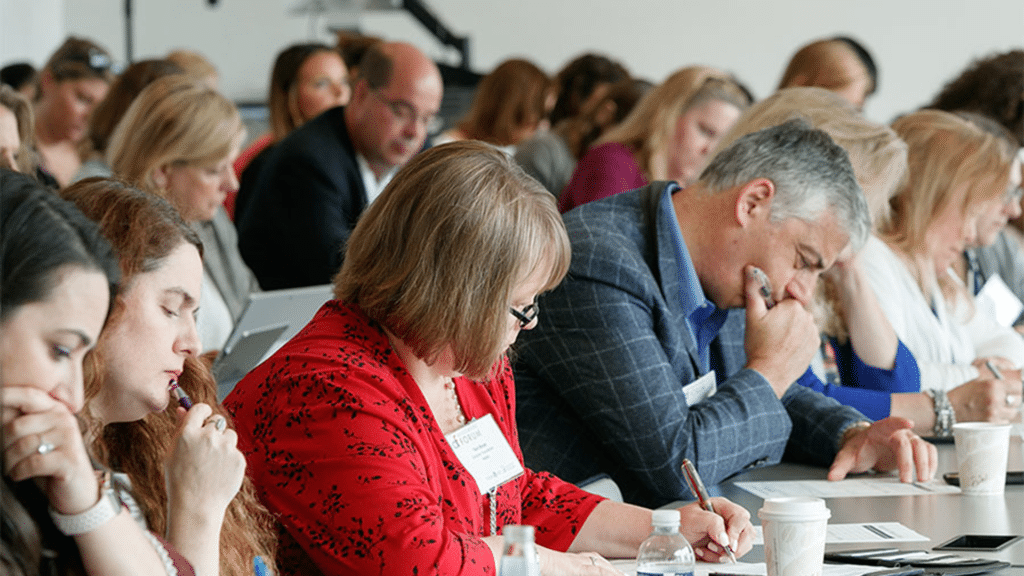Moving Past Learning Styles and Embracing Learner Engagement

 Aaron Wolowiec, Chief Executive Officer, Event Garde
Aaron Wolowiec, Chief Executive Officer, Event Garde
Aaron Wolowiec, MSA, CAE, CMP, CTA, is a learning strategist and meetings coach for leading trade associations and individual membership societies across the United States. Committed to the latest research and trends on learning, intentional networking environments and meaningful transfer exercises, he launched Event Garde, a professional development consultancy, in 2011.
The competition for associations members’ attention is fierce, both in terms of their attention spans and where they go to seek relevant content and education. The days of droning, hour-long lectures are (hopefully) behind us, but what is replacing them and how can associations capitalize on the changing needs of learners? FORUM posed these questions to Aaron Wolowiec, CEO of Event Garde, a thought leader in education who is obsessed with understanding how people learn.
FORUM: How can associations serve their members’ educational needs by better understanding how their education preferences?
You have probably heard all about learning styles, such as the VARK methodology or some other methodology where we’re thinking about visual learners, auditory learners, read/write learners or kinesthetic learners. There’s a variety of these types of methods. When I teach about these concepts, I often ask, “Which style of learner are you?” Then I pull out this book called More Lies About Learning, a collection of perspectives on organizational learning edited by Larry Israelite. In it, there are couple of paragraphs that really remind us that this idea around learning styles has been repeatedly disproven in research by many solid studies, but it’s a notion that remains pervasive. In fact, I went to my doctor’s office last year and randomly one of the questions they asked is, “What type of learner are you?”
People think that it makes sense and it sounds like a thing, but there’s no evidence to suggest that if you present content in a visual way to a kinesthetic learner, they’re going to learn it any better or worse than if it were presented in a kinesthetic way. It’s not to suggest that people don’t have preferences, it’s just that there’s no correlation between learning better or learning worse when something is presented inside or outside of the style that you prefer. I’m not suggesting that you shouldn’t present content in different ways or consider the preferences of your learners. I just think you need to provide a variety of sensory tactics during education sessions—sound, sight, taste, smell, touch—to encourage more innovation and engagement in the learning environment.
FORUM: What are some ways facilitators can engage learners in different ways?
You have to think about the different senses that can be used to engage. Are there colors and graphics that bring a visual element to the education? In terms of sound, is there music? When we think about learning spaces, particularly in person, the biggest space in the room that is difficult to fill is the air, but you can fill the air with both sound and scent, such as with an essential oil diffuser. With the element of taste, I normally have mints or candies— and at larger events there might be any variety of F&B opportunities. Then, there are the tactile elements such as paper, markers, toys, fidget spinners, stress toys and the like.
Really what we’re trying to do by engaging the senses is interrupt the brain from taking shortcuts. When a learner walks into a classroom and sees a classroom-style set or crescent rounds, their brain has been trained over time to jump to conclusions and essentially find the shortest distance between two points. In this instance, the brain might be quickly processing the following internal thought: “I know what this environment is. I’ve seen it before. I know what to expect and I can probably check out because II’ve been here and done this at other similar sessions.” If we tee up the brain differently and suggest to people that this is unfamiliar, then the brain doesn’t know what to expect. As a result, the likelihood of engagement is greater.
It’s certainly important to understand that there are different ways to access content. People can ascertain information visually through their eyes, or auditorily through their ears or kinetically through their hands and body. There’s no one option that is right for every situation. It’s about providing as much variety in a single session as possible without overwhelming the learner, because at the end of the day some people are going to like some elements and approaches more than others. If you provide enough variety, there should be a little something for everyone and it’s going to break up the concept into more manageable, bite-sized pieces.
Beyond the style elements, you have to be aware of the learner’s attention span. There’s a lot of different benchmarks for attention spans—in Brain Rules by John Medina, he suggests that the brain is ready for something new every 8 to 10 minutes and we should be changing our modality, approach or content. I’ve heard this number as low as 6 or 7 minutes. I don’t know that there are hard and fast rules to go by, but what I do know is if we’re lecturing for on for an hour on a webinar or we’re droning on for 75 or 90 minutes in front of a classroom of association professionals, that’s not going to get the job done. It’s not going to hold their attention and it’s not going to effectively deliver content that results in workplace application.
FORUM: Is there a replacement for learning styles?
I think that the replacement for some of those learning style methodologies is the opportunity for participants to practice. In thinking about how to best build presentations, many of the aspirational models suggest that the first thing you should do is capture people’s attention, so identifying different strategies early on in a presentation to do so is often the first step. Another step is to provide meaningful opportunities for participants to practice newly-learned content. It’s not just about telling you that this is a good model or takeaway or tactic, but then to allow you the opportunity to practice in the session, whether that’s working in a small group or on a case study or developing a model or action plan individually.
FORUM: What does it mean to engage learners?
I wrote an ebook with Tracy King in 2017 called Engaging Learners: A Guide to Successfully Designing Engaging Learning, and part of our thesis around engaging learners is a three-step model. Step one is creating a partnership. I can’t just ‘do learning to you’ as a participant. There needs to be a partnership between you as the learner and me as the facilitator of knowledge, and so figuring out ways to identify and build that partnership is key.
The next step is this idea of individualization or personalization. Content really has to be personalized to the learner. If I’m just talking about theoretical membership models at a session, that might be great, but what really helps the learner effectively process the information is for it to be personalized. They should be asked to identify their membership challenge, and then given time to consider how the application of the content that’s being presented could actually improve their scenario.
The last step is application and behavior change. Can the learner visualize how they’re going to apply this information when they return to their office? Will it have a meaningful impact on their behavior moving forward? It’s one thing to sit in a session and have an active partnership with the speaker and think about how the content relates to you, but it’s something completely different to go back to your organization and actually apply that information to the scenario in question or to share the takeaways and action plan with a colleague or supervisor.
FORUM: How can associations better understand their audience and use that understanding throughout the planning process?
You need to start with a diverse stakeholder group that includes speakers, target audience members, staff, board members, sponsors, exhibitors—whomever you need to include to ensure that you have a well-rounded group. Those stakeholders then become your ambassadors and cheerleaders when it’s time to market this event. I think that’s an important place to begin. You need their buy-in and their understanding of the process that went into developing this event to help spread the word when the time comes.
Moreover, associations have to be on the leading edge of what’s innovative, unique and different. This necessitates an iterative process whereby everyone who’s involved in the stakeholder group is adding, changing, editing and deleting when it comes to brainstorming and planning.
A word of caution: I think that a lot of times our association events try to copy and paste—I saw this at another event, how can it fit here? But every association is so different, that if we try to simply “copy and paste” and ignore why those specific formats or approaches worked elsewhere, they may or may not work in our specific environment. If you see something that’s really cool, dig in to why that approach or format is successful, learn from it, and then make the necessary adjustments to ensure success for your association and your learners.
One model that association professionals may be familiar with is the design thinking approach, which is intended to evaluate what you have right now (What is?), what could the future look like if you made a change (What if?), what change might have the biggest impact (What wows?), and how that change will influence or affect learners in the marketplace (What works?). This is a great, systematic model that can be used to help facilitate conversation with a diverse stakeholder group
FORUM: How associations can still be leaders in resources and education when so much is readily available online for free?
When I think about how associations can position themselves as education leaders, the two things I emphasize are curation and pathways. What I mean by curation is associations need to be the synthesizer of the best of the best content, as opposed to being a repository for everything there is to know on a topic. We often fall into the rut of thinking that more is more, but people have less time to focus, read and engage than ever before, so we have to be the people who shine a spotlight on the specific, hyper-focused content they need to know.
The second part, pathways, is all about personalization. When I go to any association website, I would stake money on there being some sort of education calendar with all the upcoming events listed by date. That’s great, but in terms of how people navigate their particular pathway and determine which of those events are really meaningful for them to attend and which aren’t, that’s a different story altogether.
Typically, when we talk about pathways, we talk about two different pathways. The first is career stage pathways—early career professional, mid-career professional, senior career professional. What are the information, resources and education I need in order to be successful at my current career level (and, incidentally, at my next career level)? The other pathway is by function—membership, meetings, and governance. Whatever the functional area may be, what’s the basic knowledge and foundational content I should know? From there, the content increases in sophistication until you have obtained the highest-level resources and takeaways. In this way, you’re teeing up content in a way that’s more of a journey and less of a choose-your-own-adventure. This provides more direction and understanding of what professionals in a specific career stage or functional area need to know. If they are already aware of the basic knowledge, then they can move on to the next level, but providing that pathway to follow is really important to the learner experience.
In this way, associations should see themselves as almost concierges or college advisors. When I went to Michigan State University, I had an advisor who sat down with me and helped me plan what I would take each semester and each year through graduation. In a similar way, associations can be that guide. By positioning themselves as an advisor, organizations can be more successful in engaging their members—getting fitted for the education that will best suit them. This often has a ripple effect into other areas of associations such as continued membership, the purchasing of resources or even becoming more involved as a volunteer.
Tags
Related Articles
Double Your Footprint: Enhancing Conferences with a Hybrid Event Workflow
By combining on-site engagement with a digital experience, hybrid events can attract diverse audiences, boost...
The Emergency Nurses Association Utilizes Design Thinking to Reimagine its Awards Ceremony
In a prime example of intrapreneurship, the ENA utilized design thinking to innovate within the...
Report Reveals Strategies to Overcome Membership Decline
McKinley Advisors’ Membership Reset report provides a roadmap that association leaders can use to refocus...


 Aaron Wolowiec, Chief Executive Officer, Event Garde
Aaron Wolowiec, Chief Executive Officer, Event Garde

